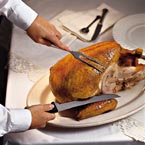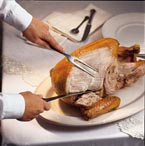



|

| |
|
Handling & Cooking Tips Chicken and turkey rank among America's most popular foods, which is why knowing how to handle and prepare poultry is more important than ever. We've divided this area into concise sections to make your search easy. If you don't find what you're looking for here, try our Frequently Asked Questions page. | |
|
| |

|
Store fresh, raw chicken in its original unopened wrapper at 40°F or less, in the bottom, coldest part of the refrigerator. Store it here no longer than one to two days, and be sure to cook or freeze raw chicken by the "use by" date on the label. For longer storage, immediate freezing is recommended. To prevent freezer burn, wrap chicken in foil or other freezer wrap. Separate parts into individual meal-size portions before freezing, so you can later avoid defrosting more chicken than you need. Refreezing chicken is never recommended. Cooked chicken should be wrapped securely before refrigerating or freezing. For optimum quality, follow the storage guidelines provided here. |

|
| ||||
TYPE |
REFERIGERATOR (40°F) |
FREEZER (0°F) |
||
RAW WHOLE CHICKEN |
1 - 2 days |
12 months |
||
RAW CHICKEN PARTS |
1 - 2 days |
9 months |
||
RAW GROUND CHICKEN OR CHICKEN GIBLETS |
1 - 2 days |
3 - 4 months |
||
FOSTER FARMS® SAVORY SERVINGS TM |
Good thru (if unopened) "use or freeze by" date |
3 - 4 months |
||
COOKED WHOLE CHICKEN OR PARTS, PLAIN |
3 - 4 days |
4 months |
||
COOKED CHICKEN PARTS WITH GRAVY OR BROTH |
1 - 2 days |
6 months |
||
COOKED GROUND CHICKEN |
1 - 2 days |
1 - 3 months |
||

|
Chicken can be conveniently and safely thawed in the refrigerator. Allow approximately three to nine hours for parts, and 24 hours for a whole chicken. If time is short, you can defrost chicken in the microwave, or place poultry in an airtight bag to thaw in cold water. Change the water every 30 minutes to keep it cold; cook the chicken immediately. Do not thaw chicken at room temperature - even if frozen inside, the surface of foods can warm up quickly, allowing bacteria to grow. |

|
| ||||
TYPE |
INTERNAL TEMPERATURE |
APPROXIMATE TIME AT 350°F |
||
WHOLE CHICKEN |
|
|
||
| 3 - 5 lb. broiler | 180°F | 1 1/4 - 1 1/2 hours | ||
6 - 8 lb. roaster |
180°F |
1 1/2 - 2 1/4 hours |
||
BREAST, BONE-IN |
|
|
||
6 - 8 oz. |
170°F |
30 - 40 minutes |
||
BREAST, BONELESS |
|
|
||
4 oz. |
165°F |
20 - 30 minutes |
||
LEG QUARTER, BONE-IN |
|
|
||
4 - 8 oz. |
170°F |
40 - 50 minutes |
||
THIGH, BONE-IN |
|
|
||
5 - 7 oz. |
170°F |
30 - 40 minutes |
||
THIGH, BONELESS |
|
|
||
3 oz. |
165°F |
20 - 30 minutes |
||
GROUND CHICKEN |
|
|
||
6 oz. patty |
165°F |
20 - 30 minutes |
||
|
Whatever method you use - roasting, frying, simmering, grilling or microwaving - be sure to finish cooking once it is started; interrupted or partial cooking may encourage bacterial growth in foods. Keep all hot foods hot (140°F to 160°F) before and during serving. Cover and refrigerate leftovers in a shallow container as soon as the meal is over. Do not leave cooked foods out at room temperature for more than two hours. A meat thermometer is your most accurate way to determine if the bird is done. For a whole chicken, insert the thermometer into the thickest part of the thigh without touching the bone. Stuffing in the inside of a chicken should reach at least 165°F. For poultry parts, check the internal temperature of several pieces, to ensure all chicken is thoroughly cooked. If you do not have a meat thermometer, cook stuffing separately, and check for doneness by piercing the meatiest part of the chicken with a fork. The fork should insert with ease, and the juices should run clear. We recommend a minimum oven roasting temperature of 350°F for chicken. The cooking chart in the box indicates safe internal temperatures and approximate roasting times for fresh or thawed chicken. | ||||

|
| ||
|
Exactly how many people will that bird feed? How do you estimate? Start with our general guidelines, below, but if Uncle Jeff has a notoriously huge appetite, or if you want lots of leftovers, buy larger.
| ||
TURKEY WEIGHT (lbs.) |
APPROX. NUMBER OF SERVINGS |
|
8 - 12 lbs. |
8 to 10 |
|
12 - 16 lbs. |
10 to 14 |
|
16 - 24 lbs. |
14 to 20 |
|
24 - 28 lbs. |
20 to 24 |
|

|
Store raw turkey in its original, unopened wrapper at 40°F or below. For optimum quality, cook fresh whole turkey within 3 to 4 days of purchase. Immediate freezing is recommended for longer storage (up to 12 months). Cook refrigerator-thawed turkey within 1 to 2 days. A turkey thawed by the cold water or microwave method should be cooked immediately. Following are important safety tips...
|

|
| ||||
TURKEY WEIGHT (lbs.) |
IN THE 'FRIDGE |
COLD WATER* |
||
8 - 12 lbs. |
1 - 2 days |
4 - 6 hours |
||
12 - 16 lbs. |
2 - 3 days |
6 - 9 hours |
||
16 - 20 lbs. |
3 - 4 days |
9 - 11 hours |
||
20 - 24 lbs. |
4 - 5 days |
11 - 12 hours |
||
|
| ||||

|
One of the best roasting methods is also the simplest...
|

|
| ||||
TURKEY WEIGHT (lbs.) |
UNSTUFFED |
STUFFED |
||
8 - 12 lbs. |
2 1/2 - 3 1/2 hrs. |
3 - 4 hrs. |
||
12 - 16 lbs. |
3 - 4 1/2 hrs. |
3 1/2 - 5 hrs. |
||
16 - 20 lbs. |
4 - 5 hrs. |
4 1/2 - 5 1/2 hrs. |
||
20 - 24 lbs. |
4 1/2 - 6 hrs. |
5 - 6 1/2 hrs. |
||
24 - 28 lbs. |
5 1/2 - 7 hrs. |
5 1/2 - 7 1/2 hrs. |
||

|
Stuffing cooked inside the bird has the ultimate flavor, but an unstuffed bird cooks more quickly. Some considerations for both methods... When stuffing your turkey (try our recipe), be sure to use a meat thermometer to assure that a safe internal temperature of 165°F is reached. Mix wet and dry ingredients and stuff loosely just prior to roasting. Do not mix ingredients or stuff the bird ahead of time. To save time and ensure safe, complete cooking - without the risk of overcooking your turkey - bake your stuffing in a covered casserole, not inside the bird. |


|
| |
|
These instructions create the most attractive cuts, so you can even carve the bird at tableside. Bring the turkey to the table on a platter. You'll need a large cutting board with wells around the edges to catch juices during dark meat carving. | |
|
START WITH THE DARK MEAT | |
 |
With a long, extra-sharp carving or chef's knife, remove legs by slicing down
and back to where the thigh attaches to the bird. Cut through the joint until
leg comes off; remove to cutting board. |
 |
With skin side up, knee facing you, separate the drumstick from the thigh,
slicing through the joint - which is closer to the drumstick bone than the
thigh. |
 |
Drumstick may be served whole or cut in thin slices on all four sides, parallel
to the bone. Cut away thigh meat in strips parallel to the thigh bone. |
|
AND NOW THE LIGHT MEAT | |
 |
Steady the turkey by holding the fork against the breastbone. Just above the wing,
make a long, deep horizontal base cut straight into the turkey as far as the knife
will go. |
 |
Make downward diagonal slices, with each slice a little higher up on the breast,
and end at the base cut. Slices will fall away onto the platter. When the first
side is done, repeat on the other. |
 |
To steady the bird, leave wings on until you've carved both sides of the breast.
To remove the wing, slice into the joint which attaches it to the body, carving
as much meat from the body as possible. |

|
At Foster Farms we've always been committed to freshness, quality and the good health of our customers, so of course we want you to have a safe kitchen. Like other raw foods, poultry should be handled with care to assure safe food preparation in the home. Wash your hands with warm soapy water for at least 20 seconds before and between cooking tasks, and dry them with a clean towel. Countertops and utensils such as knives and cutting boards must be washed thoroughly with hot, soapy water after preparing raw poultry, and before use with other foods. As an added precaution, washed cutting boards may be rinsed with a dilute, freshly made chlorine bleach solution (1 tablespoon household bleach per quart of water) Adapted from an Audits International checklist, the following should give you an idea of how safe your kitchen is. The more items you check off, the less chance you and your family have of contracting a food-borne illness. |

|
| |
|
Temperatures -
| |
Beef, ground | 155°F |
Beef, roasts/steaks | 145°F |
Casserole (rice/pasta/potato) | 145°F |
Eggs | 145°F |
Fish/Seafood | 145°F |
Meat | 165°F |
Microwaved foods | 165°F |
Pork | 155°F |
Poultry | |
Boneless | 165°F |
Bone-in parts | 170°F |
Whole (at the thigh) | 180°F |
Reheated leftovers | 165°F |
|
Leftovers -
| |
|
Cross-contamination -
| |
|
Hand-washing -
| |